More than 460,000 Employed in Newspaper Delivery
About 93 percent of Japan's roughly 53.68 million newspapers distributed daily (including morning- and evening-edition sets) are delivered to subscribers by newspaper sales agents. The delivery system covers every part of the country and is the key to the country's high newspaper diffusion rate exceeding an average of one copy per household.
An NSK survey in October 2001 found that a total of 464,827 people were working for Japan's newspaper sales agents.
Publishing companies distribute their newspapers to sales agents, which then deliver them to subscribers. Morning papers customarily arrive at subscribers' homes between 6 A.M. and 7 A.M. This delivery time is strictly observed so that subscribers in the work force can read their morning paper before leaving for their jobs.
Newspaper delivery workers include part-time female workers (42 percent of the total) and part-time male workers (29 percent). When the first NSK survey on this subject was conducted in 1963, 73 percent of the newspaper delivery workers were newspaper boys -- junior-high and high-school students under age 18. However, newspaper boys have been declining in number and proportion, with the latest survey showing them representing only eight percent of all delivery staff (see table and chart). In place of teenage boys, part-time women workers have become the core staff at newspaper delivery companies. Offering reasonable pay for short working hours, newspaper delivery is now seen as a suitable job for housewives.
In recent years, the total number of newspaper delivery workers has fallen, but newspaper agents are continuing to hire more adult employees in place of newspaper boys. They are also trying to reduce the weight of their newspapers and to cut the workload of newspaper delivery people to help maintain the newspaper delivery system.
Asahi's Usanami, Kyodo's Oikawa Win Vaughan-Ueda Prize
Yusaku Usanami, the chief of the Asahi Shimbun's General Asia Bureau, and Hitoshi Oikawa, the chief of Kyodo News' Moscow Bureau were selected as the winners of the fiscal 2001 Vaughan-Ueda Memorial Prize by the prize board on Feb. 14.
This prize is awarded to individual journalists who make contributions to international understanding through distinguished journalistic activities.
Asahi's Usanami, a veteran journalist with a track record of more than 20 years of continued reporting on Asia, is known for his deep insight into the racial, religious and historical backgrounds of Asian nations, as well as for his reporting of the latest developments in political, economic and social affairs. Many of his articles deal with the cultural aspects of Asian countries, vividly depicting the lifestyles of local people and the realities of their societies.
During the Afghanistan crisis, he flew to Islamabad and later entered Kabul, sending out in-depth reports and commentaries on the developments based on his deep insight into the undercurrents of the multicultural societies of Pakistan and Afghanistan.
On Sept. 22, after the attacks on the United States, Oikawa entered northern Afghanistan and reported on developments in Afghanistan from the Japanese perspective for about two weeks before the arrival of reporters from any other Japanese media. On the night of Oct. 7, he sent out the breaking news that the U.S. was to launch airstrikes against Kabul airport starting at midnight. The bombing began soon afterward, and his report drew respect for its credibility from various foreign media.
The Vaughan-Ueda Prize was set up in 1950, modeled on the U.S. Pulitzer Prize. It is funded by donations from the widow of Miles W. Vaughan, a late former vice president of United Press International (UPI) and Japanese media. Vaughan, together with Sekizo Ueda, a former president of Dentsu Inc., a major advertisement agency, had endeavored to establish an independent global news agency network based on collaboration between the United States and Japan. Vaughan and Ueda were lost at sea together after a gust of wind in waters off Urayasu in Tokyo Bay in January 1949. The prize was established in memory of their achievements. The prize is conferred annually to the individual journalists who most contribute to international understanding through journalistic activities. Dentsu is an offshoot of the prewar Domei news agency, from which Kyodo News and Jiji Press were also created after the end of World War Two.
Profiles of the recipients
|
Yusaku Usanami (53)
|
 |
- Born in Fukuoka Prefecture on Nov. 3, 1945,
- Graduates from History of Art Department, Literature Department, Kyoto University, in 1969,
- Joins Asahi Shimbun the same year,
- Transfers to City News Division at Osaka Head Office in 1977,
- Moves to Foreign News Division at Tokyo Head Office in 1986,
- Assigned to Bangkok General Asia Bureau as a correspondent in 1987,
- Promoted to acting Editor of weekly magazine AERA
- Appointed chief of New Delhi Bureau in 1995,
- Appointed head of General Asia Bureau and concurrently chief of Hanoi Bureau
|
|
Hitoshi Oikawa (40)
|
 |
- Born in Iwate Prefecture on Nov. 30, 1961,
- Graduates from Russian Literature Division, 1st Literature Department, Waseda University,
- Joins Kyodo News the same year,
- After serving in the Kawasaki and Chiba bureaus, studies at state-run St. Petersburg University, Russia, in 1992,
- Moves to Foreign News Division in 1993,
- Appointed chief of Belgrade Bureau in 1995,
- Assigned to Moscow Bureau in 1998
|
American, Japanese Journalists Make Exchange Visits
NSK°«s Japan-U.S. Journalist Exchange Program for fiscal 2001 saw six U.S. journalists arrive in Japan on Feb. 13. They completed a busy schedule that included conducting interviews with top leaders in various fields and making inspection tours of Okinawa and Kyoto before leaving for home on Feb. 27.
Linda Feldman, an opinion page editor at the Christian Science Monitor, said that she found Japan to be a mixture of Asia and Europe. Michael McGuire, the acting deputy managing editor of the Chicago Tribune, said he researched Japan°«s political and economic situation, as well as Japan-U.S. relations. He said he was pleased to have also been able to hear from an expert on folk culture about the legend of three monkeys that had interested him at Toshogu Shrine in Nikko.
In Tokyo, the U.S. journalists paid a courtesy call on Lower House member Taro Nakayama, who is the president of the Japan-U.S. Parliamentarians Friendship League and chairman of the Research Commisions of the Constitution. The journalists also visited the Tokyo head office of the Sankei Shimbun, NTT DoCoMo, and other places.
They made a three-day visit to Okinawa starting on Feb. 19. In Okinawa, they met reporters from the local newspapers -- the Ryukyu Shimpo and the Okinawa Times, and visited the U.S. air base in Futenma, as well as historic spots like Shurijyo Castle and Peace Memorial Park. Later, the U.S. visitors stayed in Kyoto for four days and returned to Tokyo to meet former U.N. Under-Secretary-General Yasushi Akashi and Foreign Ministry North American specialist among other officials.
The six-member Japanese journalists°« group flew to the U.S. on Feb. 13 and made a fact-finding tour of the country after the Sept. 11 terrorist attacks. Their itinerary included a visit to the State Department, the New York Times, CNN and the Seattle Times.
The U.S. and Japanese journalists got together after completing their respective visits to hold summary discussions on Feb. 28-March 1 in Hawaii.
The exchange program is a joint project of NSK, the Washington D.C.-based International Center for Journalists, and the East-West Center of Hawaii University. The program was proposed in 1970, by senior officials of Japanese and U.S. media organizations meeting at the 1st Japan-U.S. Editors Conference in Hawaii. Japan-U.S. relations were going through a tense period at that time due to a trade dispute over textile products. The exchange program was proposed as a way to try to narrow the perception gap between the two countries by promoting mutual understanding.
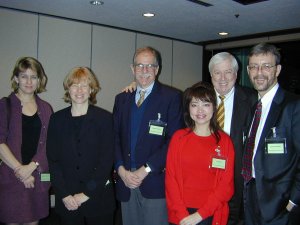 |
|
| The participants in this year's program were, from the left,
Ms. Linda FELDMANN, Opinion Page Editor, The Christian Science Monitor
Ms. Stephanie SHAPIRO, Features Reporter, Baltimore Sun
Mr. Stephen SEPLOW, Freelance, Former Reporter/Editor, Philadelphia Inquirer
Ms. Trinh LE, Editor, Fort Bend/Southwest Sun, Houston Community Newspapers
Mr. Michael McGUIRE, Deputy Associate Managing Editor, Chicago Tribune
Mr. Frank CRAIG, Editor, Pittsburgh Tribune-Review
|
Topics.......Topics.......Topics........
|
Mainichi to Introduce Expert Writers System in April
Mainichi Shimbun will in April introduce what it calls the expert writers system. By encouraging the development of "star writers," the system is aimed at attracting readers with by-line articles by expert writers. Initially, some 15 reporters will be given the designation.
The expert writers are to be of two types -- expert editorial writers with the rank of section editor and special editorial writers with the rank of assistant managing editor. The expert writers in these two categories will be nominated separately from conventional editorial writers.
Those eligible for nomination include reporters ranked below section editors who apply for the new position and win their superiors' approval, or whom their superiors recommend. Qualifications include 1) a first-class standard in terms of knowledge in particular fields, a capability to make judgments, a capability to collect news and writing capability; 2) a record of positive contribution of articles to the daily newspaper and to other Mainichi publications, as well as an ensuing contribution to the development of the company's business activities; and 3) excellence as a corporate team player with a decent personality.
Nominations will be made at a screening meeting held every February under the supervision of the Editor-In-Chief. Also at that meeting, the track records of each existing expert writer will be reviewed and nominations will be subject to possible cancellation, depending on their achievements. Expert writers are expected to write articles of far greater substance than those written by editorial writers.
Shinano-Mainichi's Reporter Competes at Salt Lake City Winter Olympics
A female Japanese newspaper reporter drew considerable notice as an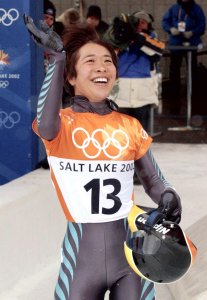 athlete in the Feb. 2-24 Winter Olympic Games at Salt Lake City, Utah, in the United States. athlete in the Feb. 2-24 Winter Olympic Games at Salt Lake City, Utah, in the United States.
Eiko Nakayama(PHOTO=KYODO), who is 31, is a reporter in the Lifestyle Division of the Shinano-Mainichi Shimbun, a daily newspaper with a circulation of 470,000 copies in Nagano Prefecture. She was chosen as Japan's representative in the sledge competition called the "women's skeleton." She finished 12th in the competition on Feb. 20.
Nakayama is a reporter in charge of the Lifestyle and Family pages. When the Winter Olympic Games were held in Nagano in 1998, she was a member of the newspaper's Sports Division and covered such sledge competitions as the bobsled and the luge. At that time, skeleton was not yet an official event in the Olympic Games. She met Kazuhiro Ochi, a Japanese skeleton athlete, became enchanted by his clean way of life, and resolved to pursue a career as an athlete.
The acceleration in speed at the time of the jump-start is crucial for skeleton races. Nakayama, who was a sprinter in her high school days, practiced before work every morning on steep stone steps near her home. After work, she worked out at a training gym every night. In the winter season, she used her paid leaves to go on expeditions.
Female reporter Kinue Hitomi of the Mainichi Shimbun, took part in the Amsterdam Olympics in the Netherlands in 1928, winning a silver medal in the women's 800 meters.
Nakayama said that by competing in the Salt Lake City Olympics, she recognized the wonder of sports and the reality of making the news, among many other things.
|
Story of this month>>>>
Newspaper Advertising Revenues Stuck In the Doldrums
|
|
Ever since spring 2001, the advertising revenues of Japanese newspapers have been dragged down by the economy's failure to climb out of its deflationary spiral. And since the start of 2002, the economic downturn has been getting progressively worse.
According to Dentsu Inc.'s annual report "Advertisement Expenditures in Japan in 2001," total advertising spending fell 0.9 percent from a year earlier to \6,058 billion, in its first year-on-year decline in two years. By type of media, advertising spending on newspapers dropped 3.6 percent to \1,202.7 billion, and the newspaper market's share in total advertising spending declined to 19.9 percent, edging below the 20 percent mark for its first time.
These recent developments led advertising spending on newspapers to make year-on-year decreases in 1998 and 1999. But riding a mild improvement in the economy, the figure subsequently increased 8.1 percent over the year earlier. The somewhat better performance was attributed to the Upper House elections, the Sydney Olympics and the launch of BS digital broadcasting, among other factors.
However, the economic upturn was not sustained, due to the slowdown in demand for information technology (IT) and the twin problems of rising unemployment and declining salaries. In summer 2001, the economy began shrinking once again. In the latter half of the year, corporate earnings deteriorated and the Sept. 11 attacks on the United States struck a critical blow against a recovery in the U.S. economy. In Japan, the mad-cow scare slashed consumer spending and unemployment continued to surge.
Against this backdrop, the volume of advertising began gradually dropping in July. The year-to-year decline exceeded six-percent for all five national newspapers (Asahi, Mainichi, Yomiuri, Nikkei and Sankei). In terms of revenues, the level of advertising remained an alarming 60 to 90 percent lower than a year earlier.
By type of industry, advertising orders from the "information/communications" sector have remained more than 20 percent lower than a year earlier since last summer in a marked turnaround from the brisk orders of 2000. Likewise, orders from the "financing/insurance" sector and the "real estate/housing equipment" industry are continuing to remain more than 10 percent down from a year earlier. The same slump is also continuing among newspapers' principal advertising clients -- the "publishing" and "automobile" industries.
Pressed by the deterioration of the economy, many corporate buyers of newspaper advertising are taking part in mergers and other corporate realignments. As a result, the overall number of conventional sources for newspaper advertising revenues is generally declining.
At the same time, business corporations are increasingly seeking advertising tools directly associated with their sales promotions. Newspapers are not the sole media industry being hard hit by the steep decline in advertising spending. In order to overcome the current difficulties, newspaper companies must seek out new sources of advertising revenue and must present detailed data demonstrating the effectiveness of newspaper advertising.
For instance, advertising about clinical trials, which began only two years ago, is attracting attention as a new type of newspaper advertising. Such clinical trials generally refer to the upcoming clinical tests of new medicines.
In Japan, clinical trials have long been dealt with as an extension of medical treatments, with the credibility of data derived from such clinical trials being relatively low. It took 10 to 15 years before pharmaceutical firms could win government approval for the commercial manufacture and marketing of new medicines. At the urging of the parties concerned who saw the situation as a crisis, the health ministry issued a notice in 1999 declaring that public calls for clinical trials did not constitute a violation of the Pharmaceutical Law.
That deregulatory move led one pharmaceutical company after another to buy advertising in newspapers, inviting the general public to participate in clinical trials of new medicines for diseases including circulatory psychosis, insomnia and atopic dermatitis. The public response to such advertising was greater than expected, leading to the birth of a new type of advertising that capitalizes on properties of newspapers such as the respect for the public interest and accountability.
Given the ever-growing public need for information related to health care and medical care, the market for health care is now one of the most promising prospective sources of newspaper advertising revenue.
With the outcome of the government's anti-deflation measures still uncertain, newspaper companies must remain armed with data and other marketing devices that enhance the appeal of newspapers to potential advertisers.
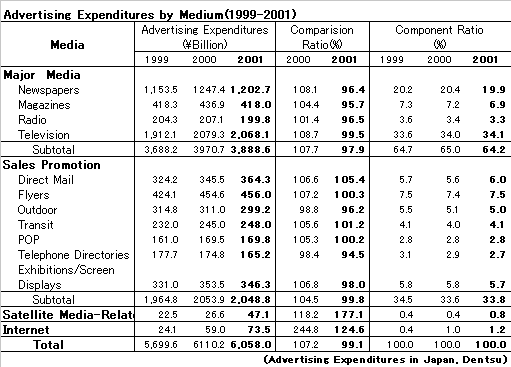
|
|
|
Nihon Shinbun Kyokai
The Japan Newspaper Publishers & Editors Association
Nippon Press Center Bldg., 2-2-1 Uchisaiwai-cho, Chiyoda-ku,
Tokyo100-8543, Japan
bulletin@pressnet.or.jp.
Copyright 2002 Nihon Shinbun Kyokai
All right reserved
|
|
|
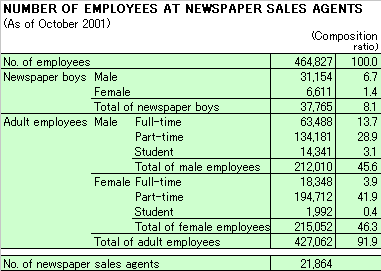
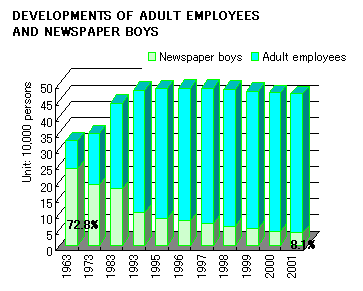



 athlete in the Feb. 2-24 Winter Olympic Games at Salt Lake City, Utah, in the United States.
athlete in the Feb. 2-24 Winter Olympic Games at Salt Lake City, Utah, in the United States.